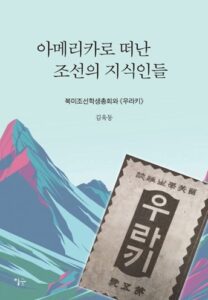
Wook-Dong Kim
Kyŏnggi-do P’aju-si: Isup, 2020.
Reviewed by: Eunjin Jung (PhD Candidate, Korea University, HYI Visiting Fellow)
From the 1920s to the 1930s, about a decade after Japan’s annexation of Korea, there was a significant wave of Korean intellectuals who crossed the Pacific Ocean to study in the United States. During this period, Korea, under Japanese colonial rule, was absorbing modernity primarily through Japan—a process the author aptly calls “Mediated Modernity” (Chungyŏktoen kŭndae). Yet, several hundred pioneering students sought to bypass this mediation by traveling directly to America to gain firsthand access to the latest knowledge and ideas from what was then considered the most advanced nation in the world.
This book traces the history of these young pioneers, focusing especially on the magazine Urak’i (The Rocky, 1925-1936). Korean students in the U.S. formed a community known as the Korean Student Federation of North America and launched a magazine aimed at readers in Korea. Their goal was to share the latest knowledge they had acquired, recount their experiences abroad, and express their hopes for Korea’s future. The magazine was titled Urak’i, named after the Rocky Mountains in North America, reflecting the students’ strength, resilience, and forward-looking spirit. Written in Korean, Urak’i published a total of seven issues between 1925 and 1936, and was distributed to Korean readers eager to learn about life and modernity in America.
Although a few sporadic studies have previously touched on this magazine, this book distinguishes itself by offering a comprehensive account of the Korean Student Federation of North America and the publication of Urak’i. The book is structured in four chapters. The first chapter explores the founding of the Korean Student Federation of North America, beginning with an overview of the broader history of Korean students studying in the United States. It highlights the increased accessibility of American education for Koreans starting in the 1920s and examines the historical significance of their presence and studies abroad.
The second chapter examines the publication of Urak’i. While the Korean Student Federation of North America also produced English-language materials such as the Korean Students Bulletin, Urak’i stood apart in that it was written in Korean and intended for readers in Korea. The book provides detailed information on the magazine’s origins, the students’ motivations for publishing it, public reception in Korea, the editorial staff, and the overall structure and content of Urak’i.
Chapters three and four present selected articles from Urak’i. Chapter three focuses on liberal arts subjects such as pedagogy, religious studies, philosophy, and gender, while chapter four highlights articles in the social sciences—including sociology, economics, racial issues, home economics—as well as scientific topics. Readers should be aware that the original text of Urak’i was written in a mixed Sino-Korean script, in accordance with the writing conventions of the time. For those unfamiliar with this style, the magazine itself may be difficult to approach. In this regard, Kim’s book serves as a valuable guide, offering curated selections and contextual explanations that help readers better understand the ideas and perspectives of Korean students in America during that period.
This book is an essential read for anyone interested in the history of Korean overseas education in the United States—particularly those who wish to understand how the early 20th-century study abroad experiences of Korean students shaped Korea’s perception of America.
The author, Wook-Dong Kim, is a leading scholar in American literature and translation studies. He has translated numerous works of American literature into Korean and has long maintained a deep interest in the activities of early 20th-century Korean students who studied abroad. In 2023, he published a follow-up volume titled Urak’i wa Han’guk kŭndae munhak [The Rocky and Modern Korean Literature], which shifts the focus to the literary content found in Urak’i, including poems, short stories, essays, translations, and literary criticism. Readers can gain deeper insights by reading both volumes in tandem.
